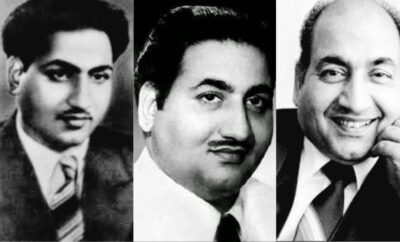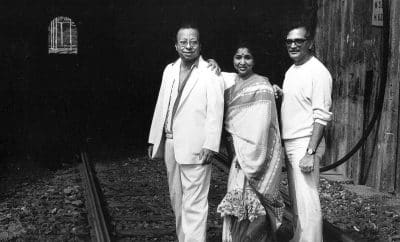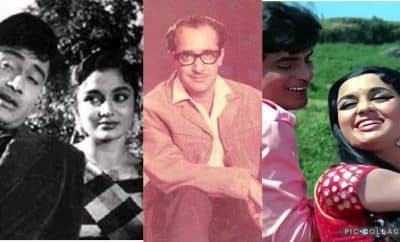Song Sketch
Safal Hogi Teri Aradhana – Aradhana – A Gospel To Endure
Year 1966 – Guide nominated for 9 categories in the 14th Filmfare awards and won 7 of the categories. The 2 categories which did not win were Best Playback and Best Music Direction. Both were won by Suraj (Shankar Jaikishan and Mohammed Rafi). That music of Suraj won over music of Guide must be a rude awakening of sorts to the music connoisseurs (excluding the fanatics here). Year 1969 – 17th Filmfare awards. Aradhana was a blockbuster and was nominated for 8 categories and won 3. Here again Best Music Direction award went to Laxmikant Pyarelal for Jeene Ki Raah. That was an awakening of sorts again!!
As the story goes, Sachin Bhowmick had narrated the story of Aradhana to Hrishikesh Mukherjee just after Anuradha (1960) but nothing constructive came out. He then narrated it to Shakti Samanta, who had just completed An Evening In Paris and who readily accepted it. The film initially was to be named Subah Pyar Ki – adapting from the lines of the famous song Raat ke humsafar….but S D Burman, who replaced Shankar Jaikishan, promptly shunned off the title. Later Shakti Samanta bought the present title Aradhana from the producer C. Mohan, who had already registered the title. Aradhana was a game changer and a smooth transition from 1960s to 1970s. It hit the jackpot for almost all the artists. The music by S D Burman (ably supported by his son R D Burman), became a blockbuster (it still remains a blockbuster). Rajesh Khanna became a National craze. For Sharmila Tagore, it was a total metamorphosis from a bikini babe in An Evening Paris to a girl next door and an unwed mother in Aradhana. Not only that, she also sported gray hair playing Rajesh Khanna’s mother, proving her versatility. Kishore Kumar was resurrected from his deep hibernation as a playback singer and Anand Bakshi was riding high with his new found success after a lull. For both these artists, their career graph is chalked as pre-Aradhana and post-Aradhana.
But Aradhana’s title song won S D Burman his first and only National Film Award for Best Playback Singer. And why not!? He has rendered it perfectly. Bringing out the true essence of the lyrics. Remoulding despair into hope. Steering philosophy into a practical direction.
Flute – an earthy instrument, often finds its place in S D Burman’s songs. Just a simple hollow piece of bamboo. But loaded with blissful music. Just like S D Burman. He’s simple, down to earth, rustic fellow and brimful with blissful music. Flute is full of emotions, full of nectar. Instruments define the energies of mind and body. They bring out the emotions of a song. Physicality, expressivity and energy. That’s how S D Burman sings – lively, wantonly –
Banegi asha ek din teri ye nirasha
Kaahe ko roye chahe jo hoye
Safal hogi teri aradhana
Kaahe ko roye chahe jo hoye
Safal hogi teri aradhana….
The song begins with ‘Karun Ras’….Karta’s voice is full of compassion and sympathy, not pity. As if he’s making a small child understand the situation. And so does the flute!! The way it is played, it is full of sympathy for the situation. Safal hogi teri aradhana……aradhana does not mean worship here, it is penance (tapasya). Sharmila Tagore’s life as an unwed mother is going to be a difficult path and a penance for her. This was just the beginning and she shouldn’t cry…..chaahe jo hoye – come what may.
Diya toote toh hai maati
Jale toh ye jyoti bane
Bahe aansoo toh hai paani
Ruke toh ye moti bane
Ye moti ankhon ki punji hai ye na khoye….
It says you have to burn like a flame to come out as a winner. Mend yourself, face the world and work hard. Learn to survive and fight your way. Crying will make you feel better but it won’t solve your problems.
Vandana (Sharmila Tagore) loses her father, (Pahadi Sanyal) who had been her moral support, creating more hurdles in her life. There’s no one to support her now. Anand Bakshi beautifully uses the metaphors of sea and storm for the emotional and the mental storm that has built up in Vandana’s life. As the lyrics become supportive of her penance, the ektara becomes supportive of S D Burman’s arcadian voice. Ektara brings out the feeling of devotion. Since at this stage Vandana needs to be devoted to her life and her unborn child.
Samaa jaaye iss mein toofaan
Jiyaa teraa sagar samaan
Nazar teri kaahe nadaan
Chhalak gayi gaagar samaan
Jaane kyun tune yoon
Asuvan se nain bhigoye…..
And again with Kaahe ko roye….it comes back to karun ras which continues in the 2nd stanza when her father dies. S D Burman, the minstrel, motivates her to live on. As the lyrics go, a garland will always have thorns along with the flowers. Life cannot be just a bed of roses.
Kahin pe hai dukh ki chhaya
Kahin pe hai khushiyon ki dhoop
Bura bhala jaisa bhi hai
Yahi toh hai bagiya ka roop
Phoolon se, kaaton se
Maali ne haar piroye…..
For the last stanza, the flute creates a peaceful ambience. A new life has come into existence, Vandana’s son. So there’s a kind of peace and happiness in her heart. And now SDB’s way of saying Safal hogi teri aradhana also changes…..coaxing her to move ahead as the flute gets sharper too. The instrumental ensemble is bare minimum. Flute, ektara, triangle, guitar and tabla. But the song is so complete even with these instruments. On the day of the recording, Pancham had arranged 12 musicians but S D Burman cut off the ‘12th man’ saying he needed only 11 and did not budge from his decision. Finally the 12th man was asked to leave with due remuneration. Minimum instruments, maximum melody and simple songs was always S D Burman’s USP and he lived by it. Just like the man himself. No pomp and show, just his awe-inspiring personality!




Pawan Agarwal
October 31, 2021 at 12:16 pm
Well written